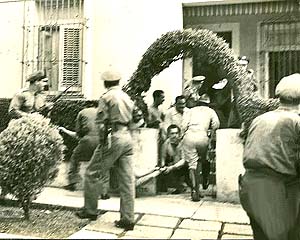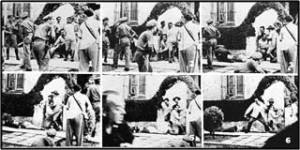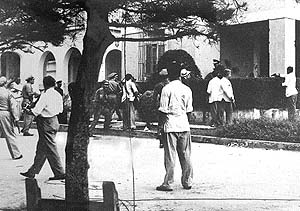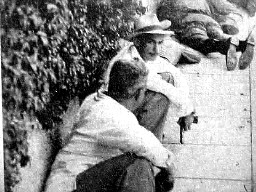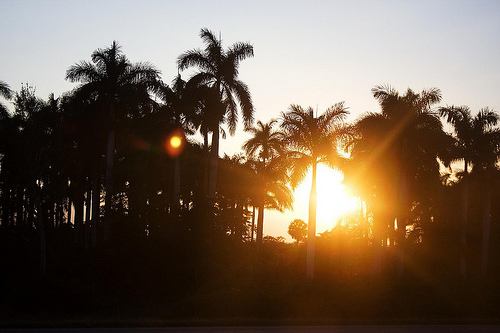It is going to be sixty-five years of the slaughter of Orfila, that event that shook Cuba on Monday September 15, 1947, when the residence of Major Antonio Morin Dopico was attacked by forces under the command of Commander Mario Salabarría. Aggression, repulsed by the besieged, lasted almost three hours and to stop imposing the intervention of troops from the Army, which rushed to the scene with twenty tanks and armored trucks. A real battle in which, among others, were killed after surrendering, and already out of the house, Major and Mrs. Emilio Tro Soler Aurora Morin, was pregnant. “I always believed that the term ‘barrage’ was merely a literary phrase, but now I know it’s a terrible reality,” he told reporters an eyewitness to the event.
Like many others, Tro and Salabarría emerged into the open after the rise to power in 1944, Ramón Grau San Martin, when many wrestlers to Autentico anti-Machado took their toll on demand for compensation or you claimed the fulfillment of the political tenets of the they dealt. Soon multiplied so-called “action groups” that settled their differences and swept clean shot at their adversaries. Grau encouraged these groups, armed and at the same time, encouraged rivalries. Tro-chief of the Revolutionary Insurrection Union (UIR) – was opposed to the group of Orlando Leon Lemus (The Colorado) and did not respect the authority of Salabarría. The differences were exacerbated when the president appointed him director of the National Police Academy and Tro insisted on installing his office in the same building where Salabarría, Chief of Research and Information Extraordinary, had its offices.
Tro’s name was linked to the bombing of the driveway Ayestarán, on May 26, 1947, from which emerged miraculously unscathed El Colorado. Dopico Morin, meanwhile, came from the “bunch” university, but was acquitted, he was supposed implicated in the death of the teacher and police chief Ramiro Valdés Daussá University in 1940. Grau, to be “regenerated” appointed him chief of police of the municipality of Marianao. Its strategic alliance with Tro was: both were enemies of Salabarría. And Blas Roca, Secretary General of the Popular Socialist Party and then-House Representative, had warned that those appointments to the police chiefs and gang members would have fatal consequences for public safety and political development of the nation.
EVENTS
On the night of September 5, 1947, the car was hit by Tro over sixty shots. Its occupants were injured, but Tro was not inside the vehicle. The attackers, said the victims were people of El Colorado, and identified each one of his men, Captain Rafael Avila. A week later, on Friday 12, Avila was gunned down in the cellar of 21 and D, Vedado. Salabarría, designated as investigating officer of the attack, succeeded, after rigorous examination, the witnesses would recognize Tro as guilty, which in the initial interviews no one had dared to do. On Saturday 13 arrest warrant was being waged against Tro, and received the mission Salabarría run.
15, at noon, Tro and three of his men went to lunch at the home of Morin Dopico, 8 corner D, Benitez cast in Marianao, a neighborhood known for Orfila, because of the pharmacy located in the area. About three in the afternoon from a patrol car shots were fired at the residence and the shooting became general. Among the attackers, who were about two hundred, were Salabarría and El Colorado. Also, Commander Robert Meoqui, Rogelio Hernandez Vega (Cuckoo) Deputy Chief of the Secret Police, José Fallat, aka The Turk …
When Tro and his companions decided to surrender and had arrived at his Army troops, who came with Gen. Gregorio Querejeta and Lieutenant Colonel Lazaro Landeira, head of the tanks. First out of the house was Dopico Morin in her arms, wound line, his daughter Miriam, just ten months old. Then came Dawn Soler and behind Emilio Tro. Everything seemed to be over when he heard again the rattle of a machine gun and Morin’s wife, mortally wounded, fell. A policeman took her by the arms to lift and tried to reach Tro ankles. A gust and fell Tro cooked to death. He tried to grab, perhaps to join, to the legs of Captain de la Osa, an aide to General Genovevo Perez, head of the army, which also wounded by the same blast. It was useless. He was fifteen holes in the chest, two in the scapular region, six skin-deep, three in the shoulder, another in the thigh and another in the face that broke his upper jaw and emptied his right eye.
Images Guayo the cameraman, National News, captured at the time shown when the Turk shot at Dawn Soler, Emilio Tro. His shooting, passing, injuring the driver of this and glared Padierne Luis, another of the men of Tro. The army prevented the slaughter continued, which resulted in six deaths from the besieged and killed and injured by the other party. Dopico Morin was taken to the Military Hospital as a detainee, and Lieutenant Colonel Landeira Salabarría arrested. It was after six o’clock in the afternoon and heavy rain fell across Havana. The blood of the victims, driven by water, covered with red pavement.
Tro’s mother was the first to accuse President Grau as responsible for the tragedy. So did many of the leading politicians of the time that the government branded as “irresponsible, inept and undisciplined” “Under the current regime there are no guarantees for women and children, respected even in the worst stages of terror in Cuba” said Senator Eduardo Chibas, while others branded the Executive fomenter of disorder and violence, and more, in a clear and definite, identified the President as “the great criminal, the great fraudster, the great murderer, the great pretender “.
The truth is that Grau, his private refuge in the Presidential Palace, refused to care for those who attended the executive mansion in order to arrange for military involvement in the fray, since it was known that Tro and Men will never be delivered Salabarría forces. It has been much speculation about the attitude of Grau. Many years later reveal a detail Salabarría unknown. The president suffered from sudden loss of memory and as it passed from Orfila was one of crisis, making it impossible to be given participation events. Someone told Genovevo General Perez, visiting Washington, of what was happening and the obese, well-ordered military vitaminized from beyond the use of the tanks to stop the killing.
The government seized copies of the National News documentary filmed every minute during the match. Students accuse President Fidel Castro Grau, his Minister of Interior and the police chief of the kidnapping aimed to erase incriminating evidence.
FINAL
Morin Dopico died in Havana in the late 80’s and about the same time her daughter Miriam left the country. Cuckoo Hernandez Vega was killed in July 48 at the Cuban consulate in Mexico City. Roberto Meoqui died in the tuberculosis hospital in La Esperanza, in 1950. The Turk , in 1951, escaped from the Castle of the Prince, where he kept imprisoned in a spectacular escape Policarpo Soler starring and directed from outside, Colorado . In February 1955, forces led by Lieutenant Colonel Martin Perez Lutgardo struck down the Colorado in the house marked No. 211, Durege Street, in the Havana neighborhood of Santos Suarez. Querejeta General died, his nineties, in Havana in 1984. Mario Salabarría , sentenced to thirty years in prison, left the Presidio Modelo in Isla de Pinos after the triumph of the Revolution, but were to fully comply with his sentence. In 1963 he was again arrested for his involvement in a failed attack tested against the life of Fidel Castro, and carried out in Revolution Square on 26 July of that year. He got his early release again and left the country. He died in United States in April 2004. Emilio Tro is a legend.
Sources: CiroBianchiRoss/InternetPhotos/TheCubanHistory.com
Episodios de la Republica/ The Cuban History/ Arnoldo Varona, Editor
GO BACK HISTORICAL PAGES OF CUBA
EPISODIOS DE LA REPUBLICA
LA MASACRE DE ORFILA
Se van a cumplir sesenta y cinco años de la masacre de Orfila, aquel suceso que conmocionó a Cuba el lunes 15 de septiembre de 1947, cuando la residencia del comandante Antonio Morín Dopico fue asaltada por fuerzas a las órdenes del comandante Mario Salabarría. La agresión, repelida por los sitiados, se prolongó durante casi tres horas y para detenerla se impuso la intervención de tropas del Ejército, que acudieron al lugar con veinte tanques y camiones blindados. Una verdadera batalla campal en la que, entre otros, resultaron muertos, después de haberse rendido, y ya fuera de la casa, el comandante Emilio Tro y la señora Aurora Soler de Morín, en estado de gestación. “Siempre creí que la expresión ‘cortina de fuego’ no era más que una frase literaria; ahora sé que es una terrible realidad”, declaró a la prensa un testigo presencial del suceso.
Como otros tantos, Tro y Salabarría emergieron a la luz pública después del ascenso al poder, en 1944, de Ramón Grau San Martín, cuando muchos luchadores antimachadistas pasaron factura al Autenticismo en demanda de compensaciones o le reclamaron el cumplimiento de los postulados políticos por los que lidiaron. Pronto se multiplicaron los llamados “grupos de acción” que dirimían sus diferencias a tiro limpio y barrían a sus adversarios. Grau animó a esos grupos, los armó y, al mismo tiempo, estimuló sus rivalidades. Tro –jefe de la Unión Insurreccional Revolucionaria (UIR)- se mostró contrario al grupo de Orlando León Lemus (El Colorado) y no acató la autoridad de Salabarría. Las diferencias se agudizaron cuando el Presidente lo nombró director de la Academia de la Policía Nacional y Tro insistió en instalar su despacho en el mismo edificio donde Salabarría, jefe del Servicio de Investigaciones e Informaciones Extraordinarias, tenía sus oficinas.
El nombre de Tro se vinculaba al atentado de la calzada de Ayestarán, el 26 de mayo de 1947, del que El Colorado salió milagrosamente ileso. Morín Dopico, por su parte, provenía del “bonche” universitario y, aunque fue absuelto, se le suponía implicado en la muerte del profesor y jefe de la Policía Universitaria Ramiro Valdés Daussá, en 1940. Grau, para que se “regenerara” lo designó jefe de la Policía del municipio de Marianao. Su alianza con Tro era estratégica: ambos eran enemigos de Salabarría. Ya Blas Roca, secretario general del Partido Socialista Popular y a la sazón Representante a la Cámara, había advertido que aquellos nombramientos en los cuerpos policiales de jefes y miembros de las pandillas tendrían consecuencias fatales para la seguridad ciudadana y el desenvolvimiento político de la nación.
LOS SUCESOS
En la noche del 5 de septiembre de 1947, el automóvil de Tro era impactado por más de sesenta disparos. Sus ocupantes resultaron heridos, pero Tro no se hallaba en el interior del vehículo. Los agresores, dijeron las víctimas, eran gente de El Colorado, e identificaron entre ellos a uno de sus hombres, el capitán Rafael Ávila. Una semana después, el viernes 12, Ávila era abatido a balazos en la bodega de 21 y D, en el Vedado. Salabarría, designado como oficial investigador del atentado, logró, luego de riguroso interrogatorio, que los testigos reconocieran a Tro como culpable, lo que en las entrevistas iniciales nadie se había atrevido a hacer. El sábado 13 se libraba orden de detención contra Tro, y Salabarría recibió la misión de ejecutarla.
El 15, al filo del mediodía, Tro y tres de sus hombres acudieron a un almuerzo en la casa de Morín Dopico, en 8 esquina a D, reparto Benítez, en Marianao, una barriada conocida por Orfila, a causa de la farmacia situada en la zona. Hacia las tres de la tarde desde un auto patrullero se hicieron disparos contra la residencia y se generalizó el tiroteo. Entre los agresores, que eran unos doscientos, estaban Salabarría y El Colorado. También el comandante Roberto Meoqui, Rogelio Hernández Vega (Cucú) segundo jefe de la Policía Secreta, José Fallat, alias El Turquito…
Cuando Tro y sus acompañantes decidieron rendirse ya habían arribado al lugar las tropas del Ejército, con las que venía el general Gregorio Querejeta y el teniente coronel Lázaro Landeira, jefe de los tanques. El primero en salir de la casa fue Morín Dopico que llevaba en brazos, herida a sedal, a su hija Miriam, de apenas diez meses de nacida. Luego, salió Aurora Soler y, detrás, Emilio Tro. Todo parecía haber terminado cuando se escuchó de nuevo el tableteo de una ametralladora y la esposa de Morín, herida de muerte, cayó al suelo. Un policía la tomó por los brazos para levantarla y Tro trató de alcanzarla por los tobillos. Una ráfaga más y Tro se desplomó cocido a balazos. Trató de asirse, tal vez para incorporarse, a las piernas del capitán De la Osa, ayudante del general Genovevo Pérez, jefe del Ejército, que también resultó herido por la misma ráfaga. Fue inútil. Tenía quince perforaciones en el tórax, dos en la región escapular, otras seis a flor de piel, tres en el hombro, otra en el muslo y otra más en la cara que le destrozó el maxilar superior y le vació el ojo derecho.
Imágenes que el camarógrafo Guayo, del Noticiero Nacional,captó en ese momento muestran a El Turquito cuando disparaba contra Aurora Soler y Emilio Tro. Sus disparos, de pasada, hirieron al chofer de este y fulminaron a Luis Padierne, otro de los hombres de Tro. El Ejército impidió que continuara la matanza, que arrojó seis muertos por parte de los sitiados y muertos y heridos por la parte contraria. Morín Dopico fue conducido al Hospital Militar en calidad de detenido, y el teniente coronel Landeira arrestó a Salabarría. Eran más de las seis de la tarde y una lluvia intensa caía sobre La Habana. La sangre de las víctimas, impulsada por el agua, cubría de rojo el pavimento.
La madre de Tro fue la primera en acusar al presidente Grau como el responsable de la tragedia. Lo mismo hicieron muchos de los líderes políticos de la época que tacharon al Gobierno de “irresponsable, inepto e indisciplinado” “Bajo el régimen actual no hay garantías para las mujeres ni los niños, respetados aun en las etapas peores del terror en Cuba”, dijo el senador Eduardo Chibás, en tanto que otros tildaron al Ejecutivo de fomentador de desórdenes y violencia, y algunos más, de manera clara y terminante, identificaron al Presidente como “el gran culpable, el gran defraudador, el gran asesino, el gran simulador”.
Lo cierto es que Grau, refugiado en sus habitaciones privadas del Palacio Presidencial, se negó a atender a los que acudieron a la mansión del ejecutivo a fin de que dispusiera la intervención del Ejército en la refriega, toda vez que era sabido que Tro y sus hombres jamás se entregarían a las fuerzas de Salabarría. Se ha especulado mucho sobre esa actitud de Grau. Muchos años después Salabarría revelaría un detalle desconocido. El mandatario sufría de repentinas pérdidas de memoria y mientras transcurría lo de Orfila estaba en una de sus crisis, lo que impidió que se le diera participación de los sucesos. Alguien avisó al general Genovevo Pérez, de visita en Washington, de lo que sucedía y el obeso y bien vitaminado militar dispuso desde allá el empleo de los blindados para poner fin a la matanza.
El Gobierno requisó las copias del documental que el Noticiero Nacional filmó minuto a minuto durante el combate. El estudiante Fidel Castro acusaría al presidente Grau, a su ministro de Gobernación y al jefe de la Policía de ese secuestro encaminado a borrar pruebas acusatorias.
FINAL
Morín Dopico falleció en La Habana a fines de los 80, y por la misma época su hija Miriam abandonó el país. Cucú Hernández Vega fue ultimado en julio del 48 en el consulado cubano de Ciudad de México. Roberto Meoqui murió en el sanatorio antituberculoso de La Esperanza, en 1950. El Turquito, en 1951, escapó del Castillo del Príncipe, donde guardaba prisión, en una fuga espectacular protagonizada por Policarpo Soler y dirigida, desde fuera, por El Colorado. En febrero de 1955, fuerzas comandadas por el teniente coronel Lutgardo Martín Pérez abatieron a El Colorado en la casa marcada con el número 211 de la calle Durege, en la barriada habanera de Santos Suárez. El general Querejeta murió, ya nonagenario, en La Habana, en 1984. Mario Salabarría, sentenciado a treinta años de prisión, salió del Presidio Modelo de Isla de Pinos después del triunfo de la Revolución, sin que llegara a cumplir íntegramente su condena. En 1963 fue detenido de nuevo por su participación probada en un atentado frustrado contra la vida de Fidel Castro, y que llevaría a cabo en la Plaza de la Revolución, el 26 de julio de ese año. Consiguió otra vez su excarcelación anticipada y salió del país. Falleció en Estados Unidos en abril del 2004. Emilio Tro es una leyenda.
Sources: CiroBianchiRoss/InternetPhotos/TheCubanHistory.com
Episodios de la Republica/ The Cuban History/ Arnoldo Varona, Editor
GO BACK HISTORICAL PAGES OF CUBA



